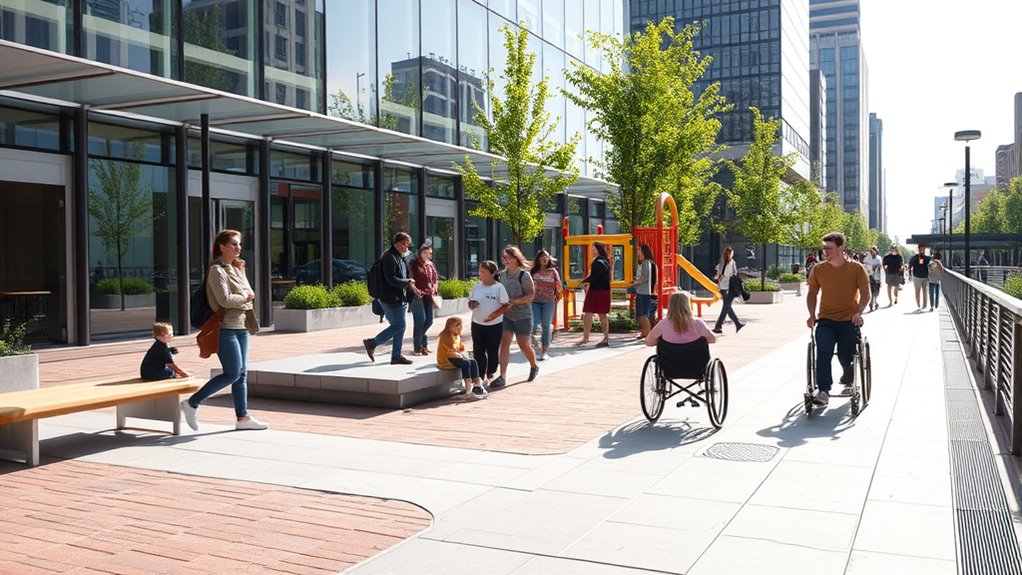Proactively designing for accessibility means thinking ahead to include everyone from the start of your project. You can do this by applying Universal Design principles, integrating assistive technologies early, and gathering feedback from diverse users. This approach not only creates more inclusive environments but also saves time and costs later. By embedding accessibility as a core element, you foster innovative, resilient solutions. Keep exploring to discover how to make your designs truly accessible from the beginning.
Key Takeaways
- Incorporate Universal Design principles early to create adaptable, inclusive environments for diverse user needs from the outset.
- Integrate assistive technologies during the design phase to ensure seamless accessibility for all users.
- Stay informed on accessibility standards like WCAG and regularly gather diverse user feedback to identify potential barriers early.
- Prioritize proactive accessibility to reduce future costs, legal risks, and enhance overall usability and inclusivity.
- Embedding accessibility from the start demonstrates commitment to empathy, innovation, and equitable experiences for everyone.

Accessibility isn’t just about fixing problems after they arise; it’s about anticipating them and building inclusive experiences from the start. When you adopt this proactive mindset, you create environments that serve everyone, regardless of their abilities or circumstances. One of the most effective ways to do this is through Universal Design, which aims to make products, spaces, and systems usable by all people without the need for adaptation or specialized design. By incorporating Universal Design principles early in your projects, you ensure that accessibility isn’t an afterthought but a foundational element. This approach benefits not only individuals with disabilities but also those who might face temporary challenges, such as injuries or age-related difficulties, and even improves overall usability for everyone.
Alongside Universal Design, leveraging assistive technologies can further enhance your proactive strategy. Assistive technologies include tools like screen readers, voice recognition software, alternative input devices, and magnification tools. When you integrate these technologies into your designs from the outset, you eliminate barriers before they appear. For instance, designing websites with semantic HTML and clear navigation allows screen readers to interpret content accurately, making digital spaces accessible without requiring users to install additional software later. Similarly, providing multiple ways to interact with a system—such as keyboard navigation alongside mouse controls—ensures that users with different needs can access content seamlessly.
Taking a proactive stance also means staying informed about evolving standards, devices, and user needs. You should continuously consult accessibility guidelines like WCAG (Web Content Accessibility Guidelines) and incorporate feedback from diverse user groups during the development process. Doing so helps you identify potential issues early and address them before they become costly fixes or legal risks. When you prioritize accessibility from the beginning, you foster inclusivity, reduce future remediation costs, and demonstrate a commitment to equitable experiences. Additionally, understanding the importance of Universal Design can guide you in creating environments that are inherently accessible and adaptable for all users.
Ultimately, designing proactively isn’t just about compliance; it’s about empathy and foresight. By embedding Universal Design principles and integrating assistive technologies into your workflows, you ensure your projects are resilient, inclusive, and ready for a diverse audience. You shape environments that empower everyone to participate fully, making accessibility a core part of your creative process rather than an afterthought. This approach not only benefits users but also elevates your reputation as a thoughtful, innovative creator committed to true inclusivity.
Frequently Asked Questions
How Can Small Startups Implement Proactive Accessibility Effectively?
You can implement proactive accessibility by fostering an inclusive culture where everyone values diversity. Start early by integrating accessibility into your design process and conducting regular early testing with diverse users. This approach helps identify issues early, making your product more accessible from the outset. Engage your team, gather feedback, and adapt continuously to create an inclusive experience that benefits all users and strengthens your startup’s reputation.
What Are Common Misconceptions About Proactive Accessibility?
Think of proactive accessibility as planting a garden—you might assume it’s too complex or costly, falling into assumption pitfalls or believing in implementation myths. Many think accessibility is a one-time fix or only for certain users, but it’s an ongoing process that benefits everyone. Don’t fall for these myths; instead, embrace inclusive design from the start, ensuring your product is welcoming and usable for all users.
How Does Proactive Accessibility Impact Overall User Experience?
Proactive accessibility enhances your overall user experience by embracing Universal Design principles, making your product usable by everyone from the start. It encourages higher User Engagement because all users, regardless of ability, can access and navigate easily. When you prioritize proactive accessibility, you reduce frustration, increase satisfaction, and build a more inclusive environment. This approach not only benefits users but also strengthens your brand’s reputation for thoughtful, accessible design.
Are There Specific Tools to Help Design Inclusively From the Start?
Think of designing inclusively as planting a garden from seed—you don’t wait until it’s bloomed to contemplate accessibility. Tools like assistive technology integrations and design guidelines such as WCAG help you build with accessibility in mind. They serve as your blueprint, guiding you to create user-friendly experiences from the start, ensuring everyone can navigate your site effortlessly. These tools turn your vision into an inclusive reality.
How Can Organizations Measure the Success of Proactive Accessibility Efforts?
You can measure your proactive accessibility efforts by tracking accessibility metrics like user engagement, error rates, and compliance levels. Additionally, gather user feedback regularly to understand how inclusive your design feels to diverse users. Combining quantitative data with qualitative insights helps you identify areas for improvement, ensuring your accessibility initiatives are effective and truly inclusive. This approach allows you to continuously refine your strategies for better digital inclusivity.
Conclusion
By embracing proactive accessibility, you verify your designs welcome everyone, much like the inventor who imagined the future long before it arrived. You no longer wait for issues to arise; instead, you build inclusivity into every step, preventing the need for a TARDIS to fix problems later. Start thinking ahead today, and you’ll create experiences that are truly timeless—accessible to all, no matter the era or ability. It’s the way to stay ahead in the game of inclusive design.









